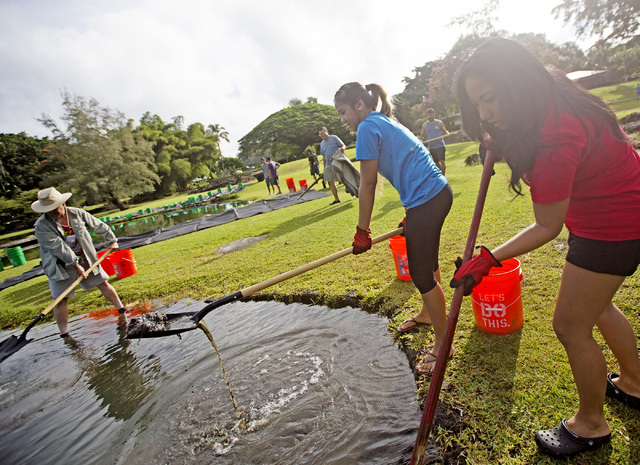The day was so calm and clear that Liliuokalani Park and Gardens’ tall pines and precise bridges were reflected perfectly in the water of Waihonu Pond. ADVERTISING The day was so calm and clear that Liliuokalani Park and Gardens’ tall
The day was so calm and clear that Liliuokalani Park and Gardens’ tall pines and precise bridges were reflected perfectly in the water of Waihonu Pond.
The pond itself, however, was less clear than it appeared.
Along its banks, volunteers armed with rakes and shovels pulled mud from the pond and dumped it into green buckets. The group of about 30 people had arrived at 8 a.m. Saturday morning. By 10 a.m. nearly 30 gallons of muck had been scraped out.
The team was just beginning. Saturday’s work day is part of an ongoing effort to prepare the gardens for their hundredth birthday.
“The centennial’s coming up pretty fast,” said K.T. Cannon-Eger of Friends of Liliuokalani Gardens. The nonprofit group formed in 2012 specifically to prepare for the milestone anniversary.
Liliuokalani Gardens was dedicated in 1917 when land was set aside for the park. Construction began in the fall of that year, but because of a host of setbacks (including a tsunami and World War I) it wasn’t until 1919 that the gardens officially opened to the public.
“The bottom line is we get to have a three-year party,” Cannon-Eger said. The party officially starts in January, with events taking place throughout the year.
The friends group recently finished a 14-month project to thin the park’s stand of tall bamboo. Cannon-Eger said she often heard from people about their memories of running through the bamboo before it was overgrown, and from adults who played “fort” in the bamboo as children. Volunteer Howard Kawabata grew up nearby and remembers the gardens being his playground all summer long. He had only a couple of hours to spare Saturday but turned out anyway to help.
“I hope that this place continues,” he said. “It’s meant for the entire island.”
Kawabata indicated the tall trees growing around the 24-acre space, most of which were more than 60 years old.
“They survived all the tsunamis,” he said.
“There’s so much history here,” Cannon-Eger said.
With the bamboo project largely wrapped, more focus shifted to the pond, which Cannon-Eger described as “the heart of the garden.”
“We’re trying to keep the pond healthy,” she said.
Debris from trees, particularly the pines, blows into the pond and can’t get out. Trapped in the mud, it decomposes, leaving layers of old plant material as well as a telltale stench.
The gallons of muck volunteers pulled out would go to the University of Hawaii at Hilo’s farm. Left outside, rain would wash the salt from the material so it could be used to help new gardens grow.
“It’s great mulch,” said Friend of Liliuokalani board member Alton Okinaka. “We might as well give it to someone who can use it.”
Over time the volunteers plan to raise the pathways that crisscross the pond, which get flooded over during high tide, and construct a round-roof pavilion on the far end of the gardens. There are also four lanterns to be restored. Each lantern represents a Japanese prefecture that sent immigrants to Hawaii.
Cannon-Eger said the director of a Japanese garden in Denver recently visited the park and had immediately noted how inviting the space was.
“He said, ‘This is a people’s park,’” she recalled.
Email Ivy Ashe at iashe@hawaiitribune-herald.com.




